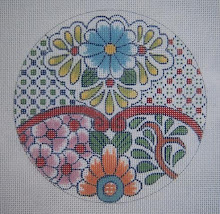 If you came here from the other blog, you are probably totally confused now about the terminology of this thing - I'm going to revert to what we call things now, which is much easier - I was fascinated with the information as I researched it, so had to pass it along.
If you came here from the other blog, you are probably totally confused now about the terminology of this thing - I'm going to revert to what we call things now, which is much easier - I was fascinated with the information as I researched it, so had to pass it along.Anyway, the first picture is a swatch of needlepoint I stitched from a really pretty fabric I saw on a quilt. This is where I get the plaids I like to adapt to needlepoint. I find them in decorating magazines as upholstery fabric, and in all kinds of other catalogues and magazines, on the internet, of course, - and at the grocery store where people are wearing them.
When you start creating your own, you'll start seeing them everywhere, and be more aware of them. This one is so simple, I thought it would be a good one to illustrate setting it up. I decided on this scale - a small square of 18 mesh canvas - to make each stripe just four threads wide. On a larger project, I would increase the width of each stripe. Correct scale is very important to the look of a piece of needlepoint incorporating a plaid, and it's so easy to create.
 I used to use the black Pilot pen to make the markings, but the Sharpie drawing pens in color have made life easier, as it's now less confusing in the stitching. Here, I used blue and yellow, of course, and left the white stripes with no marks at all. Started in the first photo with just the blue to show how it's done. I did use the black pen to draw a corner as a guide.
I used to use the black Pilot pen to make the markings, but the Sharpie drawing pens in color have made life easier, as it's now less confusing in the stitching. Here, I used blue and yellow, of course, and left the white stripes with no marks at all. Started in the first photo with just the blue to show how it's done. I did use the black pen to draw a corner as a guide. 
The second picture shows the yellow stripes marked, and also blue and yellow down the side where the weft will be worked - just as with weaving a fabric. The loom is warped, then the weaving is done with weft. I chose, on this swatch, since the blue/yellow/blue stripe is visually heavier than the b/w/b, to center it for symmetry. (I'm picky about this, even on a little demonstratio
 n.)
n.) Stitching is begun on the vertical stripes - always first - and worked on the WARP threads, as that is the strength of any fabric, including needlepoint canvas. Starting with the weft - going across - would distort the canvas. Only basketweave is used here, but "skipped" to use every other stitch, leaving the weft stitches bare for filling in the horizontal stripes.

The last picture indicates beginning the warp - and the arrow points to the weft stitch. This is where the fun begins, as the stripe goes on across, filling in and making little solid squares, etc. - and where it crosses another color, it's a different look.
In doing a multicolor plaid, it never gets boring!! I plan to have an actual project - even if it's only a simple egg shape with an initial or space for silk ribbon flowers - to show how to actually USE a plaid you've created yourself.
If you look at this little plaid a bit, you can see how easy it would be to make a new pattern (your own Tartan, perhaps) by just widening a stripe, adding a line of another color, etc. etc. - it can be very addictive once you get started!

No comments:
Post a Comment